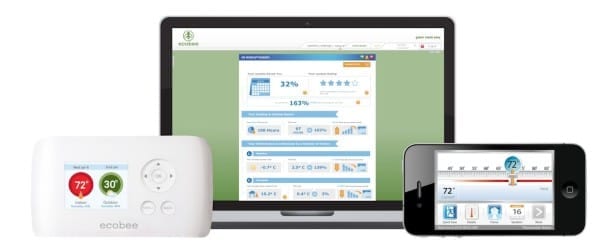As we are extremely excited about what 2014 holds in store in terms of technology, Mechanical Hub takes a look back at the most influential products of 2013. Technology is continuously improving and this is evident with the evolution of thermostats. The next generation of thermostats are here. Gone are the days—in most homes—of the mercury-filled and/or dial thermostats. Digital t-stats with intuitive platforms are the norm. How cool is that you can monitor your home’s comfort from your tablet, smart phone or Internet from just about anywhere? And, not to mention, they just look cooler.
Here are some thermostats that have made some waves in the industry:
• ecobee Smart & Smart Si with Home IQ™ — Guest blogger Max Rohr reviewed some of the latest technology from ecobee. To recap, here is what he said: While the physical unit is the first thing to make an impression, there is a big brain behind the display. You can control something as simple as one stage of heat or something as complicated as a geo system with an economizer, humidifier, and ventilate a room based on CO2 levels. In some markets, you can even add a ZigBee Smart Plug to connect with local utility smart energy programs.
 The Internet connection process has been streamlined. No need to hard wire an Ethernet cord to a gateway or call an IT guy. Every thermostat has a Wi-Fi chip built in. If you can set up a laptop on a wireless network, you can set up an ecobee stat. When you select the equipment you are using in the installation settings it will even give you a specific picture of the wiring diagram you should use.
The Internet connection process has been streamlined. No need to hard wire an Ethernet cord to a gateway or call an IT guy. Every thermostat has a Wi-Fi chip built in. If you can set up a laptop on a wireless network, you can set up an ecobee stat. When you select the equipment you are using in the installation settings it will even give you a specific picture of the wiring diagram you should use.
The newest feature that ecobee has added is Home IQ™. On a monthly basis, ecobee will have insights for you based on your heating and cooling usage. With the information logged, it even gives your home an energy efficiency rating based on how fast your building loses heat. Additionally, they use your runtime data to calculate how much your ecobee system has saved you compared to a constant temperature hold thermostat. From a contractor’s perspective, the thermostat begins creating a cost savings case study for your homeowner the day you plug it in.
• Bosch Thermotechnology customizable thermostats — As part of its Total Comfort Control solution for enhanced indoor air quality (IAQ), Bosch Thermotechnology introduced customizable thermostats that communicate directly with geothermal heat pumps and other HVAC systems in home applications. Bosch’s new thermostats have been designed for application versatility: they not only can work with Bosch’s residential Greensource Series geothermal heat pumps, they can also be used with other home HVAC system including split system air conditioners, other heat pumps, gas furnaces and even dual fuel / hybrid equipment. They can be used with gas, electric and oil-fired systems and can be added-on or retrofitted to existing geothermal heat pumps or other HVAC systems.
 Bosch communicating thermostats enable the homeowner to save on energy bills. The Bosch thermostat can even send out alerts about the unit’s operation, notifications of a dirty filter, to change humidifier pad, change high-efficiency UV (ultraviolet) filters or PCO (photo-catalytic oxidizer), and unit operating efficiency notification. The thermostat has a built-in permanent backup battery – if the thermostat has a fault, it can operate the unit in safe mode, thus preventing the home from freezing in winter or overheating in summer. The Bosch communicating thermostat can display alerts at the thermostat, so the customer can readily view how their heating and cooling system is operating. With touchscreen control at one’s fingertips, Bosch communicating thermostats take the guess-work out of when to perform maintenance on heating and cooling equipment and any Bosch IAQ accessories that may be part of the home comfort system.
Bosch communicating thermostats enable the homeowner to save on energy bills. The Bosch thermostat can even send out alerts about the unit’s operation, notifications of a dirty filter, to change humidifier pad, change high-efficiency UV (ultraviolet) filters or PCO (photo-catalytic oxidizer), and unit operating efficiency notification. The thermostat has a built-in permanent backup battery – if the thermostat has a fault, it can operate the unit in safe mode, thus preventing the home from freezing in winter or overheating in summer. The Bosch communicating thermostat can display alerts at the thermostat, so the customer can readily view how their heating and cooling system is operating. With touchscreen control at one’s fingertips, Bosch communicating thermostats take the guess-work out of when to perform maintenance on heating and cooling equipment and any Bosch IAQ accessories that may be part of the home comfort system.
Bosch communicating thermostats are lead-free and mercury-free and are available in touchscreen controlled formats. Both models come with digital displays and non-volatile memory capability, meaning that they do not lose information and pre-set programs during power outages.
• Nest Thermostats — Say what you want about the Nest, it has made quite an impression. From its impressive (inexpensive) price tag to its DIY installer friendly interface to its big box availability, the Nest is attractive to the average homeowner. (We advise that all mechanical work should be installed, serviced and maintained by a certified professional.)
 Less than a year after the launch of the Nest® Learning Thermostat™, Nest Labs, Inc. announced the next-generation of the award-winning Nest thermostat, which is 20 percent slimmer and now compatible with 95 percent of low-voltage residential heating and cooling systems. Nest is also releasing version 3.0 of its software. New and existing customers will get several industry-first features that help to even better balance comfort and conservation.
Less than a year after the launch of the Nest® Learning Thermostat™, Nest Labs, Inc. announced the next-generation of the award-winning Nest thermostat, which is 20 percent slimmer and now compatible with 95 percent of low-voltage residential heating and cooling systems. Nest is also releasing version 3.0 of its software. New and existing customers will get several industry-first features that help to even better balance comfort and conservation.
“In the past year, we’ve accomplished a number of notable milestones, from having Nest thermostats connected – and saving money and energy – in every U.S. state and across Canada to achieving best-seller status at Lowe’s, Amazon and Apple’s online store,” said Tony Fadell, Nest founder and chief executive officer. “Our mission is to keep people comfortable in their homes while helping them save energy, and with the next-generation Nest Learning Thermostat, we’re able to spread that comfort and savings to even more homes – and to help higher-efficiency systems perform the way they were meant to.”
The second-generation Nest Learning Thermostat is 20 percent thinner and has a new all-stainless steel ring that mirrors your wall color or pattern to create a chameleon effect and blend into any décor even more effectively. Now compatible with 95 percent of low-voltage heating and cooling systems, the second-generation Nest thermostat extends support to two-stage cooling, three-stage heating, and emergency heat for heat pumps, as well as whole-home humidifiers and dehumidifiers.
More than 90 percent of connected Nest owners use the remote control feature, so in addition to support on computer web browsers, apps for iPhone, iPad and Android smartphones, Nest now supports Android tablets, including Nexus 7 and Kindle Fire.




Join the conversation: